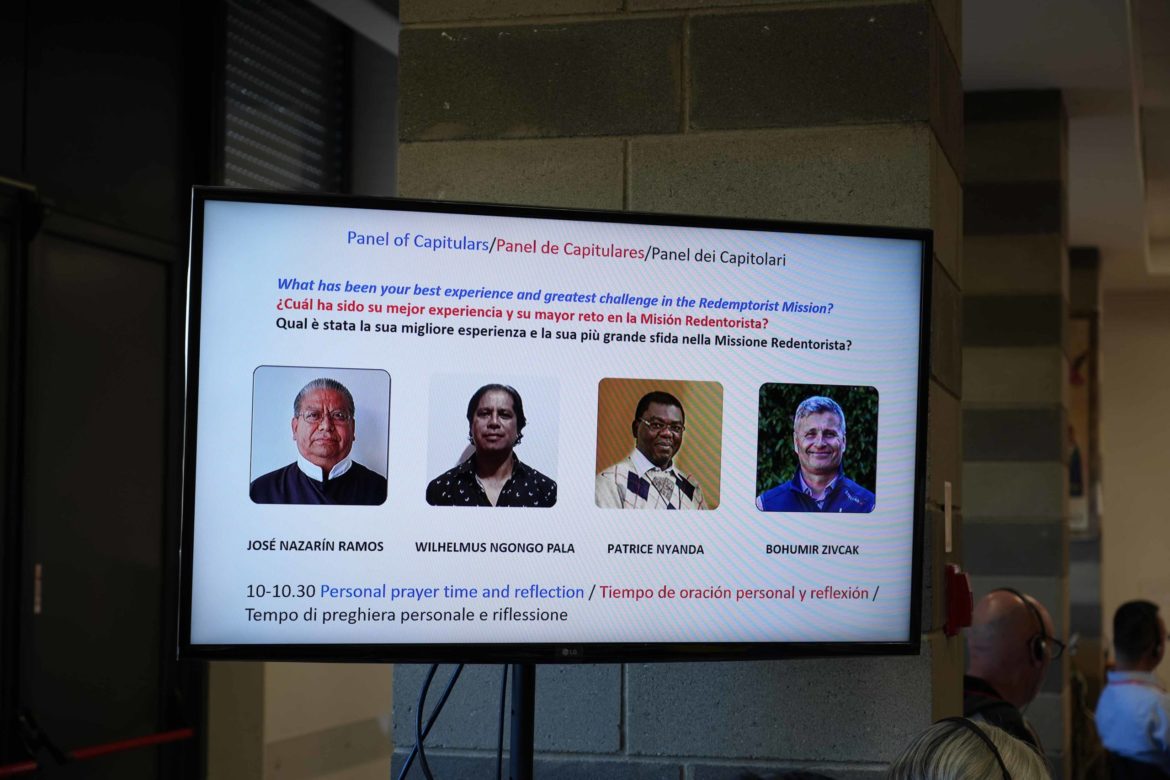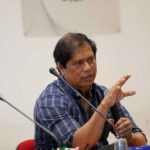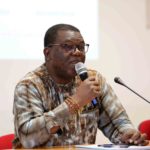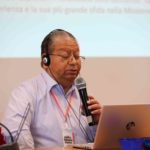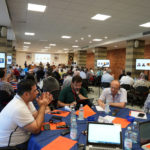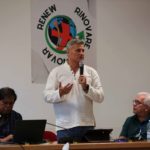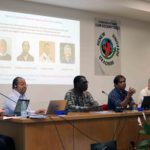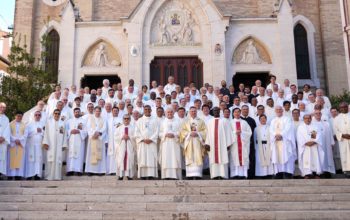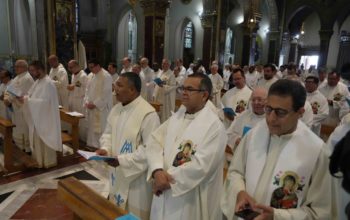The chapter members once again gathered at the auditorium to engage in a serious reflection and discussion on the Redemptorist Mission on the 20th of September. The session began with the morning prayer led by the Province of Sao Paulo, Brazil at 8.30 am. During the prayer, there were special prayers of petitions presented by different conference coordinators praying for various challenging needs of the conferences esp. safety and relief for the hurricane-affected in Taiwan, peace in the disturbed areas of Africa, missioning to the most abandoned in the missionary areas, etc.
Soon after the prayer, four members of the Chapter shared their missionary experiences, they are Fr JOSÉ NAZARÍN RAMOS, CSsR. (Province of Mexico), WILDELMUS NGONGO PALA, CSsR. (Province of Indonesia), PATRICE NYANDA, CSsR. (Vice-Province of West Africa), Mr. BOHUMIR ZIVCAK (Bratislava – Prague)
Fr Nazarin recalls the mission with the indigenous people. The indigenous Mission was carried out in the Sierra Tarahumara, in the north of the country, specifically in the Parish of the Holy Family located in the Municipality of Carichi, Chihuahua, one of the poorest municipalities in Mexico. The inhabitants of the parish are located in three zones: White-mestizo. – It is the most populated (50%), has better communications, is the least dispersed, and has greater economic resources. Rarámuri-mestizo. – (20%) They maintain their traditional indigenous structure but also adopt other ways of being typical of the white culture. Rarámuri. – (30%) Is the most limited in many ways.
The challenges among the indigenous people are: First to know a culture it is important to know its language. I was only satisfied with knowing the basics. The second was to try to support them in education, health, and the defense and care of the land, but we remained paternalistic. We were not able to understand their being as Rarámuris and walk with them, accompanying them in their lives. Thirdly, at the level of the Province of Mexico, not all the confreres agreed with this experience among the indigenous people and some never knew the place for various reasons. The Parish was handed over in February 2015.
Fr Patrice begins his mission experience as being fruitful and challenging one that allowed him to get an idea of the variety of geographical horizons, cultural traditions, and languages that exist in the Redemptorist Congregation. These are indications of the missionary dimension of the Congregation embedded in the heart of the Church itself, which is missionary.
An African proverb says, “The young tree has inherited its fruitfulness from its mother, but it produces its fruit by its roots.” The Vice Province West Africa to which he belongs celebrated the 75th anniversary of missionary presence in Burkina Faso and Niger last year.
Another aspect of the Redemptorist mission was and is that of interculturality and the missionary dimension of the Congregation always called to adapt to the concrete realities in which the Redemptorist lives and exercises his mission.
We are members of a congregation to which we have been called by Christ the Redeemer. We have been chosen by Him to serve the Father and the most abandoned. We have been called to serve. This makes us different from the men of the world because we dedicate our lives to a mission that is not our own creation, but God’s. And as our founder desired, we want to carry on Christ in today’s world.
The greatest challenges of the Redemptorist mission are as follows. African wisdom teaches that “to know where you are going, you must remember where you came from.” It is in tune with another proverb that states, “We are the heirs of our predecessors, the collaborators of our contemporaries, and the providence of those to be born.” In other words, the young generation of Redemptorists in the 21st century cannot ignore the experience of its elders, the missionaries of the first hour. It is by appropriating and assimilating their courage that we can continue the work of evangelization in the heart of this wounded world that God loves and where he invites us to be Sowers of hope.
Regarding our various missions in Africa and Madagascar, the predominant activity remains that of parishes. Two trends emerge: The first is that we should entrust parishes to the dioceses and rediscover what most identifies us: popular missions, preaching retreats, shrine animation, and development work. – Second, we must maintain our presence in parishes, infusing the breath of the Redemptorist charism into ordinary pastoral work. A dilemma that invites us to “rethink” in the spirit of this general chapter our way of being Redemptorists.
Fr Wildelmus shares how after the pandemic, the Indonesian Redemptorist Mission Team returned to carry out what is the mandate for every redemptorist. What attracts most and challenges in doing ministry as such:
The Popular Mission carried out is to preach for 1 or 2 weeks, from the preparation stage to the preaching week at the end of the mission. Methodologically the popular Mission is divided into four stages: Initial preparation is to establish initial contact with the parish or outstation, The opening of the mission during the week, namely: Launching of the mission, visits, and invitations to the faithful (Catholic families) to participate in the mission, training of lay missionaries for three days and their inauguration on the weekend. Mentoring week is for children, young people, and couples, as well as structures in parishes or stations, and the final week of receiving the sacraments and the final week of the Mission will be the preaching and celebrations as usual in missions.
One of the strengths of our mission is the pastoral visit of the families. Sometimes non-Catholic families, including Muslims, also ask us to visit and share stories of life. To get to know their situation, we usually go all the way to the kitchen. Why? On the veranda, you can borrow and put a neighbor’s chair and table, but you cannot borrow the contents of the kitchen. If it is empty then you know the economic situation.
Our mission team consists of 7 confreres. This team was specifically assigned to our Redemptorist original apostolate. The team continues like any other community with common prayer and celebrating the Eucharist (recollection), eating, recreation together and of course, planning apostolic work and evaluating it as well.
In our mission, Our Lay missionaries are playing the most important roles. we always rely on lay missionaries. We cannot do anything without their presence. They are chosen from among the local community and who are willing to work with us and committed to our mission. The whole mission period is their training period. Usually, every weekend is their formation period (evaluation of visits and planning). It was a time for them to learn how to carry their missionary commitment. Of course, this requires constant commitment from them, which is sometimes not always easy.
Missions are seen as moments of creativity (preaching the new gospel). As missionaries what we understand is to be with them. There we are SEEING THE REALITY, SPEAKING THE REALITY, and STARTING TO RESPOND TO THE REALITY, starting to do something and find new ways.
Mr. BOHUMIR being of German origin recalls how he came to know the Redemptorists and started the work of evangelization being part of them. He shares his mission experiences being as Closeness to the people, Sharing life to the deepest level (mutual), friendship, partnership, discipleship, Creative courage in the difficult and limited times, Passion for missions, opening doors, providing roofs, releasing young people into mission work and do the missions in all kinds of environments, growing partnership – this was crucial for me as a man in the church and especially as a layman. There are great challenges that cannot be ignored, such as we are losing our closeness to the people, increasingly individualistic life, weakening the community life and witness, and falling into a routine.
There were various group presentations in the afternoon. The day concluded with the audio-visual presentation of the conference of Asia-Oceanea followed by presentations and clarifications.
